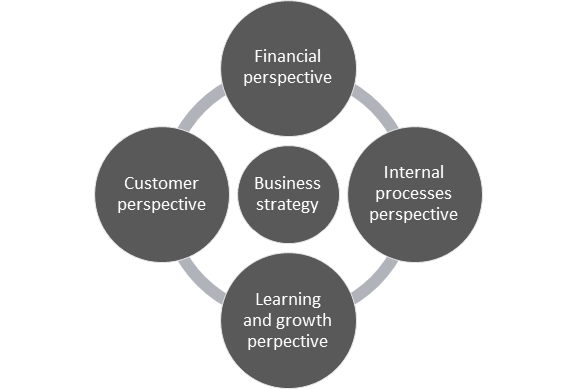Many companies are following only financial indicators in their monthly reporting. This is a big mistake because such analysis can’t show a full picture of the performance of the company.
Reporting systems working only with financial indicators are outdated. If we want to achieve the best performance we need to use more comprehensive ways of measuring the performance of the company.
The Balanced Scorecard (BSC) is a tried-and-tested way of measuring and managing all aspects of a performance of a company. I am not a big fan of a dogmatic approach to management methodologies, but we can certainly take and use ideas that the Balanced Scorecard brings. The general idea of the Balanced Scorecard is that the company must be seen and managed in multiple connected perspectives.
The general version of the Balanced Scorecard is using four perspectives to measure and manage performance:
- financial perspective,
- customer perspective,
- internal processes perspective,
- learning and growth perspective.
A balanced approach to all these perspectives is the best way to achieve company’s strategic goals.

The Balanced Scorecard is useful not only for measuring performance but also for strategic management. It helps to achieve strategic plans of the company. The Balanced Scorecard is used to determine strategic goals which can be divided into more detailed objectives including specific tasks and indicators used to assess the completion of each objective.
Devising a business strategy is a needed prerequisite for the implementation of the Balanced Scorecard. A company determines its objectives and indicators based on the strategy. Objectives and indicators must be created for each perspective that is being used.
Objectives in all perspectives must be observed simultaneously. This does not mean that there is no hierarchy between the perspectives. The most important one is the financial perspective followed by the customer perspective and by the internal processes perspective. The least important is the learning and growth perspective.
In order to avoid information overload, it is important to follow a rule that every person only receives the reports that are relevant to them. Each perspective can contain multiple detailed reports and it is not a good practice, for example, to send marketing report to an HR director. Marketing report would be part of the customer perspective but an HR director is usually interested in learning and growth perspective.
Each perspective must have its own objectives
Measures used to assess objective completion in each perspective can be both qualitative and quantitative. It is important not to forget about qualitative indicators. Omitting them from the performance measurement can distort assessment of some aspects of the performance of the company.
The following table is showing examples of objectives and measures for each perspective:
| Financial perspective | ||
| Objective: | Measure: | |
| Improve profitability | Net margin | |
| Increase sales | Analysis of sales | |
| Customer perspective | ||
| Objective: | Measure: | |
| Increase a number of advisory projects | Analysis of projects undertaken | |
| Improve client satisfaction | Regular evaluation meetings with clients | |
| Internal processes perspective | ||
| Objective: | Measure: | |
| Improve work efficiency | Number of projects relying on automation | |
| Reduce nonchargeable hours | Utilization | |
| Learning and growth perspective | ||
| Objective: | Measure: | |
| Growing sales from new types of projects | Analysis of sales | |
| Success rate of employees in professional exams | Ratio of successful and unsuccessful exam attempts | |
You can’t do this without a strong IT system
The Balanced Scorecard requires a strong, reliable and fast system for generating reports. If such a system is missing in a company, using the Balanced Scorecard approach could lead to the extremely high number of unusable reports that take ages to generate. This situation must be avoided at all costs.
The best way is to rely on automation as much as possible. Reports must be delivered to their users with no effort from their side. This does not mean that you need to invest in very expensive IT systems. Using reasonably priced systems in a smart way can create a very robust system for performance management in your company.

